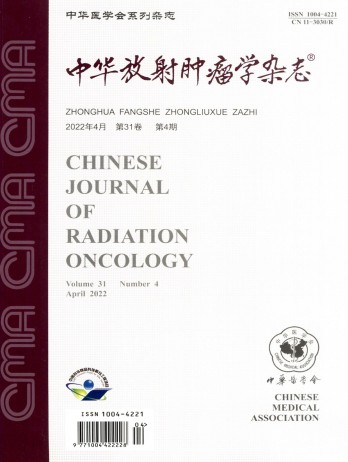局部危险因素对N0期食管癌症强化放疗患者长期预后的影响
引用次数: 0
摘要
目的探讨癌症局部危险因素对N0食管鳞状细胞癌根治性调强放疗(IMRT)后总肿瘤体积(GTV)复发的影响及其对10年生存率的影响。方法回顾性分析2005~2010年河北医科大学第四医院374例临床N0食管鳞状细胞癌根治性IMRT患者的临床资料。284例患者行受累野照射,90例患者行选择性淋巴结照射。69例患者同时进行放化疗,38例患者依次进行放化疗。采用Kaplan-Meier法进行生存分析。预后分析采用多变量Cox回归模型。结果GTV复发143例,占38.2%。GTV患者的最大横径(GTV-D)、GTV体积(GTV-V)和GTV体积/长度(GTV-V/L)明显长于GTV无复发者(P=0.008、0.043、0.001),GTV-L和GTV-V/L是GTV复发的独立危险因素(P=0.021和0.009)。整个组所有患者的3、5和10年生存率分别为42.9%、23.2%和7.9%,分别地多因素分析表明,年龄、T分期、同期放化疗、GTV-D和GTV-V/L是生存的独立危险因素(P=0.027、0.000、0.018、0.009和0.034),生存时间超过5年的患者的主要死亡原因仍与癌症有关。结论食管癌症局部危险因素对N0食管鳞状细胞癌根治性放化疗后GTV复发有显著影响,可作为预测标志。GTV-D和GTV-V/L与患者的10年生存率显著相关。关键词:食管肿瘤/放化疗;原发性肿瘤床复发;预后本文章由计算机程序翻译,如有差异,请以英文原文为准。
Effect of locoregional risk factors on long-term prognosis of patients with N0 stage esophageal cancer receiving intensity-modulated radiotherapy
Objective
To evaluate the effect of locoregional risk factors of esophageal cancer on the recurrence of gross tumor volume (GTV) in patients with N0 esophageal squamous cell carcinoma after radical intensity-modulated radiotherapy (IMRT) and to evaluate its effect on the 10-year survival of patients.
Methods
Clinical data of 374 patients with clinical N0 esophageal squamous cell carcinoma who underwent radical IMRT in the Fourth Hospital of Hebei Medical University from 2005 to 2010 were retrospectively analyzed. Involved-field irradiation was performed in 284 patients and selective lymph node irradiation was given in 90 patients. Concurrent radiochemotherapy was conducted in 69l patients and sequential radiochemotherapy was performed in 38 patients. The survival analysis was carried out by Kaplan-Meier method. The prognosis analysis was performed by multivariate Cox’s regression model.
Results
A total of 143 patients (38.2%) had recurrence in GTV. The maximum transverse diameter (GTV-D), GTV volume (GTV-V) and GTV volume/length (GTV-V/L) of GTV patients were significantly longer than those without recurrence in GTV (P=0.008, 0.043, 0.001). ROC curve analysis showed that the optimal diagnostic thresholds for GTV-D, GTV-L, GTV-V and GTV-V/L for GTV recurrence were 3.5 cm, 5.5 cm, 24.0 cm3 and 4.6 cm2, respectively (P=0.000, 0.003, 0.000 and 0.000), and the ratio of recurrence within GTV in the patient group was significantly greater than that in the smaller group (P=0.000, 0.002, 0.001 and 0.000). GTV-L and GTV-V/L were the independent risk factors of recurrence in GTV (P=0.021 and 0.009). The 3-, 5-and 10-year survival rates of all patients in the whole group were 42.9%, 23.2% and 7.9%, respectively. Multivariate analysis demonstrated that age, T stage, concurrent radiochemotherapy, GTV-D and GTV-V/L were the independent risk factors of survival (P=0.027, 0.000, 0.018, 0.009 and 0.034). The main cause of death in patients with a survival time of more than 5 years was still associated with cancer.
Conclusions
The locoregional risk factors of esophageal cancer exert significant effect on the recurrence of GTV in patients with N0 esophageal squamous cell carcinoma undergoing radical radiochemotherapy, which can be utilized as the predicting markers. Both GTV-D and GTV-V/L are significantly correlated the 10-year survival of patients.
Key words:
Esophageal neoplasm/radiochemotherapy; Recurrence of primary tumor bed; Prognosis
求助全文
通过发布文献求助,成功后即可免费获取论文全文。
去求助
来源期刊
自引率
0.00%
发文量
6375
期刊介绍:
The Chinese Journal of Radiation Oncology is a national academic journal sponsored by the Chinese Medical Association. It was founded in 1992 and the title was written by Chen Minzhang, the former Minister of Health. Its predecessor was the Chinese Journal of Radiation Oncology, which was founded in 1987. The journal is an authoritative journal in the field of radiation oncology in my country. It focuses on clinical tumor radiotherapy, tumor radiation physics, tumor radiation biology, and thermal therapy. Its main readers are middle and senior clinical doctors and scientific researchers. It is now a monthly journal with a large 16-page format and 80 pages of text. For many years, it has adhered to the principle of combining theory with practice and combining improvement with popularization. It now has columns such as monographs, head and neck tumors (monographs), chest tumors (monographs), abdominal tumors (monographs), physics, technology, biology (monographs), reviews, and investigations and research.

 求助内容:
求助内容: 应助结果提醒方式:
应助结果提醒方式:


